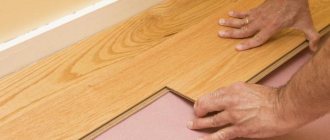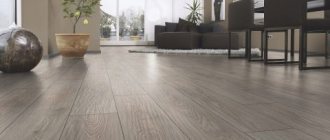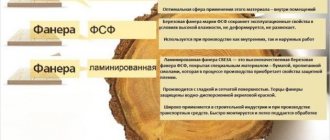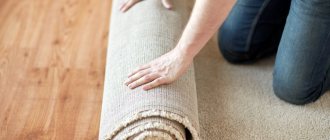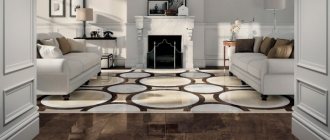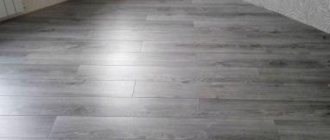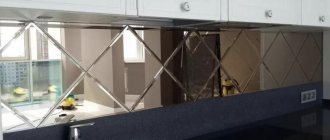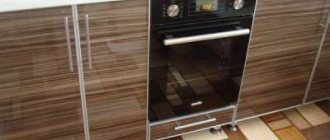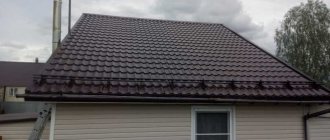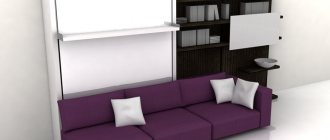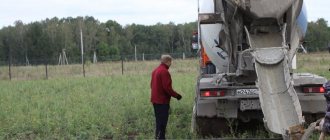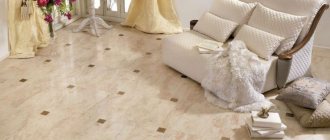Laminate is considered a practical, stylish floor covering. The best underlay for laminate flooring is a guarantee of durability and beautiful appearance of a modern coating. The underlying non-woven layer smoothes out unevenness of the base, does not allow moisture and loud sounds to pass through, and retains heat. If you cannot determine which laminate underlay will best perform its functions, we suggest that you familiarize yourself with the samples presented in the rating of the best materials. The top 14 included underlays of various thicknesses for laying on wooden and concrete floors.
Types of underlays for laminate
The modern construction market offers a wide range of underlayment materials, differing in the types of raw materials, release form (sheet, roll), origin (artificial, natural) and other characteristics. To understand which substrate is best for laminate under specific operating conditions, you need to familiarize yourself with the following factors:
- Features of the apartment.
- Substrate thickness.
- Installation difficulty level.
- The cost of the selected building material.
- Declared service life.
- Environmentally friendly material.
- Resistance against aggressive environments, fungi, rodents, harmful microorganisms, etc.
In the rating review you will learn not only about popular samples, here we will talk about materials developed using innovative technologies.
Why do you need a backing for laminate flooring?
Laminate flooring is laid using floating technology. This indicates that the elements are not secured to the base. Therefore, it is necessary to provide a shock-absorbing layer. For this you need a substrate. Its presence is associated with the performance of various functions:
- The surface is leveled. Construction documents set out the requirements that the subfloor should not have differences of more than 2 cm per 1 linear meter. If this indicator is greater, then the floor should be leveled. Small flaws can be easily eliminated by shock-absorbing fabric.
- The underlay will protect against excessive noise. Laminate does not have the ability to absorb sound. During operation this manifests itself quite clearly. Soft insulation will dampen small noises.
- The insulating coating will prevent moisture from entering the slats. Laminate is made by pressing wood raw materials. If moisture gets on it, it will have a detrimental effect on the material. The backing will protect against moisture penetration.
There is only one conclusion. Laying a backing is mandatory.
Which underlay for laminate flooring is best to choose?
When choosing the most suitable underlayment for a floor covering in specific conditions, it is necessary to take into account certain factors:
- If your apartment is located on the ground floor, it is better to buy a laminate underlay with increased thermal insulation properties.
- When arranging children's rooms, it is recommended to give preference to materials that provide sufficient insulation from noise.
- In rooms located above bathrooms and other rooms with high humidity, it is best to use materials that do not allow moisture to pass through as a substrate.
It is up to the owner to decide which underlay for laminate flooring is best installed in your apartment. Before purchasing, we advise you to familiarize yourself with the technical and operational characteristics of the selected option, user reviews, and listen to the recommendations of experienced professionals.
Why do you need a laminate underlay?
The name of the product speaks for itself. The substrate is an underlying thin layer of rough material. Available in the form of rigid sheets or soft roll products from polymer and wood raw materials.
The pads are designed to provide:
- Proper installation of laminated parquet, that is, leveling out minor defects in the rough surface.
- Protection of the floor covering during operation from residual moisture, sand, etc.
- Cushioning comfort when walking allows you to dampen dynamic loads, and also increases the level of noise reduction and thermal insulation.
Thus, underlay products are an integral part of the laminate. It is not without reason that well-known manufacturers Pergo, Balterio, Tarkett, Quick Step and others produce series with linings already integrated into the lamella (usually cork or XPS).
The thickness of the underlay recommended by laminate flooring brands is 2-3 mm. According to the results of many years of research, this is the optimal value. Violation of the basic condition can lead to damage to the locks, the appearance of unwanted creaks, cracks and other defects.
Many buyers are interested in whether it is possible to do without bedding at all. The answer to this question was given long ago by manufacturers of laminated coatings and enshrined in the EPLF technical leaflet (European standard CEN/TS16354). According to this document, the flooring system includes a mandatory combination of laminate + underlay + hard subfloor. It is in this combination that the finishing cladding performs its functions 100% and serves the 15-20 years stated by the manufacturer.
From the above it is clear that excluding the substrate from the “laminated floor – base” connection will lead to disruption of the normal functioning of the system. Simply put, unnecessary friction, annoying squeaks, a “drum” effect, swelling of certain areas and other unpleasant consequences will appear very quickly. Is it worth saving on durability and peace of mind?! Let's add to this one more immutable fact: coverage installed in violation is automatically removed from the warranty.
The best underlays for laminate flooring made from natural materials
A substrate made of natural materials has a whole range of advantages. Most often it is made from different components of wood (shavings, chips, cork); natural or artificial resins and adhesives can be used to connect small fractions. The only disadvantage of natural substrates is the high price. Experts have identified several high-quality products.
Steico Underfloor
Rating: 4.9
The most environmentally friendly layer between the base and the laminate is Steico Underfloor. It is made from natural coniferous wood, the individual fibers are bonded into a single whole using tree resin. The manufacturer offers its products in the form of rectangular slabs measuring 790x590 mm; depending on the homeowner’s requirements for the degree of thermal insulation, a substrate with a thickness of 3.6-7 mm is selected. The material takes first place in the ranking for its excellent properties; it is not afraid of moisture, solvent or glue.
Experts note good leveling abilities; the use of the product allows you to smooth out differences in height up to 3 mm. Users often use the material when laying laminate flooring in children's rooms.
Advantages
- environmental friendliness;
- good leveling abilities;
- wide range of thicknesses;
- high performance.
Flaws
- not detected.
The best substrates for polymer laminates
Synthetic substrates perfectly combine an affordable price and good performance characteristics. They create a reliable barrier to cold and moisture at the boundary between concrete and laminate. But the soundproofing capabilities of composite materials are limited. The experts selected several products.
Eco-cover
Rating: 4.9
The domestic Eco-cover substrate is widely used. It is a product based on vinyl acetate and ethylene. Environmentalists have no complaints about the safety of the material, so it can be used both in office premises and in residential buildings and apartments. Experts note excellent leveling abilities, and due to elasticity and high strength, the surface of the coating is hard. The product is produced in the form of slabs; for ease of transportation they are rolled into rolls.
The substrate wins our rating for its excellent technical characteristics. It successfully combats noise, moisture, and retains all its qualities over a wide temperature range (-40...+80°C). Finishers praise the material for its ease of use and large selection of sizes.
Advantages
- wide scope of application;
- good sound insulation;
- moisture resistance;
- ease of operation.
Flaws
- high price.
ReFoam 3002
Rating: 4.8
The ReFoam 3002 substrate has one of the best noise insulation indicators (21 dB). The material is cross-linked polyethylene, which is safe for use in children's and medical institutions. Experts value it for its high density and elasticity. Thanks to the combination of these qualities, the underlay is easy to use, and the floor covering is characterized by integrity. The production technology was invented in Japan, and the products are produced and sold in Russia. The stores offer rolled products (10x1.2 m), the optimal rigidity of the laminate is ensured with a thickness of 2 mm.
The product does not have the best water absorption capacity, so it is not recommended to use it on the first floors of high-rise buildings where there is a basement under the floor. The material ranks second in the ranking.
Advantages
- good sound insulation;
- strength and elasticity;
- ease of transportation and installation;
- no smell.
Flaws
- does not absorb moisture.
Rating of the best laminate underlays
| Nomination | place | Name of product | rating |
| The best underlays for laminate flooring made from natural materials | 1 | Steico Underfloor | 4.9 |
| 2 | Premium Cork | 4.8 | |
| 3 | PARCOLAG | 4.7 | |
| 4 | Tarkett cork backing | 4.7 | |
| 5 | Isoplaat | 4.6 | |
| 6 | Arbiton Cork | 4.5 | |
| The best substrates for polymer laminates | 1 | Eco-cover | 4.7 |
| 2 | ReFoam 3002 | 4.6 | |
| The best extruded polystyrene substrates | 1 | VTM, ISOPOLIN | 4.6 |
| The best polyethylene substrates | 1 | Tuplex | 4.7 |
| 2 | Foil Izolon PPE | 4.6 | |
| 3 | Izolon PPE | 4.5 |
How to choose a substrate for laminate
- Many Russian users, following the example of their neighbors, are beginning to take care of their health and that of their relatives. Therefore, they prefer environmentally friendly building materials. On sale you can find products made from natural raw materials (wood) or high-quality synthetic analogues. At this stage, it is important to take into account the propensity of different people to allergies, reactions to odors, etc.
- Thermal insulation.
Laying the underlay allows you to improve the microclimate in a particular room. First of all, this concerns heat. Residents of private houses and apartments located on the ground floor should choose a substrate taking into account its thermal insulation properties. - Soundproofing
. In a multi-storey building, poor sound insulation becomes a serious problem. In order not to hear noise in the apartment on the floor below, you should give preference to materials that absorb sound and vibration. - Thickness.
High-quality installation of laminate flooring is only possible on a flat surface. This is difficult to achieve on a screed or old plank base. But with the help of a substrate it is possible to eliminate unevenness and differences in the floor. The worse the base, the thicker the layer under the laminate is chosen. The standard thickness is 3 mm. - Moisture resistance.
Modern flooring (laminate, parquet boards) is quite sensitive to moisture. And if spilled liquids can be eliminated in a timely manner, then high humidity from floor panels or screeds will lead to swelling of the panels. It is best to do a simple test to determine the moisture content of the substrate by placing plastic wrap over it overnight. If no perspiration appears by morning, then a regular base will do. - Manufacturer.
As for the choice of manufacturer, today domestic brands compete on equal terms with imported manufacturers. Some of them use foreign developments and technologies, others introduce their own inventions.
Our review includes the best underlays for laminate flooring. When compiling the rating, the opinions of experts and reviews of domestic consumers were taken into account.
Technology of laying the substrate under the laminate
- Additional leveling of the floor may be required before installation.,
since the substrate cannot hide too significant differences in height. The permissible height difference is no more than 2 mm per 1 m of length or a uniform slight slope of no more than 5 cm over the entire length of the room. - The floor must be dry. If the concrete screed is fresh, then you need to wait until it dries. You can check the humidity level by placing a jar with the neck down or by placing polyethylene on a screed overnight. If condensation is noticeable in the morning, it means the subfloor is not dry enough and you should wait to lay the flooring.
- It is also important to clear the floor of any debris.
- It is recommended to first lay a thin layer of polyethylene on a relatively new screed for additional waterproofing. When using a waterproof PVC laminate, no waterproofing is required.
- The underlay should not be glued to either the subfloor or the laminate.
- Corrugated material must be laid with the uneven surfaces facing down. The foil backing is placed with the reflective side up to achieve better heat retention in the room.
- You can cut the substrate with either scissors or a knife. The markings are applied with a marker - it will still not be visible under the floor.
- The underlay is laid perpendicular to the direction of laying the laminate.
- You should not cut the substrate along the edge of the walls , but make an overlap of several cm on them, which will subsequently be covered with a plinth. Over the floor area, a substrate made of fiberboard, cork, polystyrene foam and polyethylene foam is laid end-to-end; it is recommended to seal the joints with adhesive tape. The polyethylene is laid overlapping, the joints are also sealed.
Preparatory substrates
Preparatory substrates are used in addition to the main ones in cases where it is necessary to additionally prepare the floor. For the purpose of waterproofing, roll materials are used - bitumen, bitumen-polymers and polymers. They are applied to a fixing mastic on a pre-primed floor.
Cast waterproofing is made from the same bitumen and polymer substances, as well as asphalt. Heated to a liquid state, it is applied with a brush to the concrete floor screed. For the same purpose of protection from moisture, you can put a plastic film on the floor. It should be a little thicker than the polyethylene we are used to in bags, so as not to collapse too easily and quickly.
Laying the substrate
Laying the substrate under the laminate is quite simple and does not require special skills or complex tools. All you need is a stationery or any other sharp knife for cutting the material, a ruler, tape measure and a marker for marking. Wide adhesive tape or masking tape is used as a fixative.
The underlay must be laid perpendicular to the selected direction for laying the laminate.
It is not recommended to lay the underlay over the entire room at once. Possible falling of tools, movement in shoes, or ingress of debris can damage its integrity, resulting in loss of performance characteristics. It is enough to lay down the amount of underlay needed for several rows of flooring, and then gradually add it, immediately covering it with new rows of laminate.
Laying is done joint-to-joint or overlapping, the joints are glued together. On top of the substrate along the perimeter of the walls, it is necessary to place limiters to ensure a distance of 1-2 cm from the walls.
They should not be secured with anything, and before installing the skirting boards they must be removed completely. They are necessary only during the installation of laminate flooring in order to provide the flooring with room for expansion or contraction when temperature and humidity fluctuate during operation.
